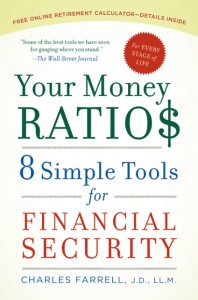I recently read Your Money Ratios, 8 Simple Tools for Financial Security, by Charles Farrell.
The Disclaimer
I was asked to review this book in exchange for a copy, and chance to give a copy to one of my readers. This didn’t influence my thoughts on this book which are genuine and my own. I did however pick up this book with a bias. Charlie Farrell wrote an article on CBS Market Watch titled Don’t Rush Into Roth IRA Conversions. With all of the cheerleading surrounding the Roth IRA, this article echoed the warning that I’ve written about myself. I consider it serendipity to have read this article shortly before I began reading Your Money Ratios.
The Ratios
Capital to Income – Very simply, your current saved assets compared to your current annual income
Savings Ratio – The percent of your income you need to save each year
Mortgage to Income Ratio – How large your mortgage is compared to income
Education Debt – Amount owed compared to income
Investments – percent ratio of stocks and bonds
Disability Insurance – The monthly income you’d get as a percentage of current income
Life insurance – The number of years salary of the policy
Long Term Care Insurance – Insurance for this care, kicking in at age 55
Financial authors run a risk, too much detail and a reader will lose interest, too little, and the message may not get across. In this case, I think Charles Farrell did an excellent job straddling that line, staying on point, and keeping my attention throughout the book. To be honest, he had me at “when it comes to your money, and your future, you want to be Mr. Spock, not James T. Kirk.”
Charles offers a step by step process, so the reader isn’t left on his own to fill in the blanks. Starting with an 80% of income replacement target (where did that come from? Well, if you’re saving 12% and another 7.65% goes to payroll witholdings, you’re living on 80% now) we are walked through the percent of income to save at different ages and how to invest this savings in order to reach the target. I’d point out that the assumption is for Social Security to provide 20% of one’s working income. If you object, thinking this is too high, my Social Security Benefits post from last May should put your mind at ease. The benefit is regressive so a $90K earner may get $27K/yr (30%) but a $50K earner will get nearly $21K (42%) so Charles’ numbers are actually conservative.
Frequent reference is made to his Unifying Theory of Personal Finance:
“All decisions you make should help move you from being a laborer to being a capitalist”
This is not a poke at people who work with their hands. It’s an encouragement to save enough wealth so your money’s return has a significant impact. Consider, the first few years of savings, the interest or growth on your account doesn’t feel like much. But once your savings are equal to a year’s pay, a 10% increase is nearly as much as the 12% you add to the account, and it’s grown by 22% in that year.
I think that this book would benefit people at any stage of their life (hmm, maybe the blurb on the cover stating “for every stage of life” really sunk in). Someone just starting out can get a good understanding of how to start on a good financial path, knowing in their 20’s what their goal is 30 some years hence. An older reader can get an understanding of whether or not they’re on target and perhaps better calculate what their goals are. More than anything, the writing style and tone of the book was something that put me at ease. We are offered targets but not made to fell that these number are rigid, carved in stone. Even the replace ratios are offered as targets, 80% at age 65, but a fallback position of 70% at age 65 or 70 is also discussed if one either can’t reach the 80%/65 or doesn’t need that sum.
There is also an invitation to go to Your Money Ratios website and check out how you rate, your Money Mass Index.
I’d do a disservice to not be clear about what you won’t find in this book. The investing method is simple, a mix of stocks and bonds with a brief reference to diversifying with international stocks. Some might object that this section might have been expanded upon. For a comprehensive overview of asset, I’d suggest a book such as William Bernstein’s The Intelligent Asset Allocator. From a practical standpoint, the mix of stocks and bonds suggested will have a far greater impact than the further diversification within the groups is likely to provide. In the end, an enjoyable and educational read.
The Giveaway
To help promote the book, the publisher has offered me a copy to give away to one lucky reader. If you wish to be entered for the drawing please sign up for my RSS email subscription and I will chose a winner on January 31. Yes, you can unsubscribe after the drawing, but you wouldn’t want to, right? (Note – this giveaway is valid only for my readers in the US and Canada, they cannot ship elsewhere.) Good luck!
Joe


Excellent review, Joe! Thanks so much for all the time and effort that went into reading and reviewing this book. It is greatly appreciated. I’m off to Tweet your contest!
THANKS SO MUCH… LOOKS LIKE A BOOK EVERYONE NEEDS THESES DAYS